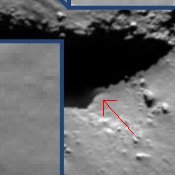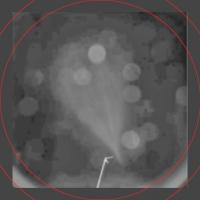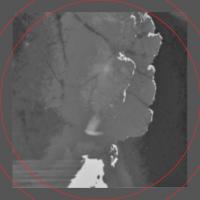Philae landing on the nucleus of Comet 67P C-G |

  |
Philae landing on the nucleus of Comet 67P C-G |
 Jan 7 2015, 08:13 PM Jan 7 2015, 08:13 PM
Post
#1186
|
|
 Member    Group: Members Posts: 241 Joined: 22-August 05 From: Stockholm Sweden Member No.: 468 |
ADMIN EDIT: There is no need to "quote" a comment that is directly before yours. This has been raised many times before.
If you match the images carefully you can actually measure a couple of distances there. there is a lot of depth there. And slightly over the ellipses there is an overhanging rock that is close and only visible in the right image. so it blocks further stereo coverage. |
|
|
|
 Jan 8 2015, 09:17 AM Jan 8 2015, 09:17 AM
Post
#1187
|
|
|
Member    Group: Members Posts: 107 Joined: 1-August 14 Member No.: 7227 |
I'm experimenting with my 3d model of the cameras FOVs, but I'm really in trouble with getting a 60° large rectangle INSIDE a 70° large circle, there's something wrong here... maybe even in the SPICE kernel?!?
I must check with some trigonometry and geometry if it is actually possible to draw such a rectangle inside such a circle. |
|
|
|
 Jan 8 2015, 10:09 AM Jan 8 2015, 10:09 AM
Post
#1188
|
|
|
Member    Group: Members Posts: 107 Joined: 1-August 14 Member No.: 7227 |
My math appears to say that:
- if 60° rectangular FOV was right, circular FOV would be 78°, not 70° - if 70° circular FOV was right, rectangular FOV would be 52°, not 60° Also manual measurement appears to confirm such results. Unfortunately this does not match with SPICE kernel. What am I doing wrong? |
|
|
|
 Jan 8 2015, 11:48 AM Jan 8 2015, 11:48 AM
Post
#1189
|
|
|
Member    Group: Members Posts: 378 Joined: 21-April 05 From: Portugal Member No.: 347 |
.... I see only a very few features in common between the two frames - those I've circled in black here: ... Yes, there seems to be some overlap at the bottom edge of the frames. Looks correct, since the cameras are tiled down. Perhaps the FOV uncertainties come from that. Could be that the number given is the horizontal FOV at the middle of the frame... -------------------- _______________________
www.astrosurf.com/nunes |
|
|
|
 Jan 8 2015, 02:53 PM Jan 8 2015, 02:53 PM
Post
#1190
|
|
|
Junior Member   Group: Members Posts: 46 Joined: 20-November 14 Member No.: 7342 |
My math appears to say that: - if 60° rectangular FOV was right, circular FOV would be 78°, not 70° - if 70° circular FOV was right, rectangular FOV would be 52°, not 60° I've noticed a very strong vignetting type effect in the corners of several of the CIVA images published. In fact it rather closely matches your image if you compare the 70 degree circle to the 60 degree square. I wonder if 70 degrees doesn't amount to the max usable field of the optics. The square optical detector cuts off that max usable optical field in some places and exceeds in others. Note vignetting in corners of these CIVA images: http://sci.esa.int/rosetta/54965-frame-fro...iva-p-camera-2/ http://www.bbc.com/news/science-environment-30524429 http://sci.esa.int/rosetta/54966-frame-fro...iva-p-camera-3/ http://sci.esa.int/rosetta/54967-frame-fro...iva-p-camera-4/ I'm assuming that for images that don't show the vignetting effect (or only show it in some corners), either the effect is hidden because that portion of the image is all black, or the image has been cropped. The CIVA camera appears to return 1024x1024 images, meaning that some of the above have been cropped and/or scaled. On edit: Scalbers makes that point upthread: "this document suggests the side of the square is 60 degrees, and the 70 degree measurement is partway to the corners." See diagrams starting page 9. Once you understand how it works you can see they have carried through that type of diagram on some of the other diagrams linked upthread--even in the SPICE ASCII diagrams. So I think your diagram does pretty much sum up the situation. P.S.--Some truly amazing detective work from a number of people tracking down details of the CIVA cameras upthread. Wow! |
|
|
|
 Jan 8 2015, 04:39 PM Jan 8 2015, 04:39 PM
Post
#1191
|
|
|
Junior Member   Group: Members Posts: 46 Joined: 20-November 14 Member No.: 7342 |
I found a third moving dot in the images, and shadows direction does not allow supposing one dot is a shadow. I was tipping more in the direction of 'possible camera artifact' for those little dots, but finding a 3rd one really does push it much more in the direction of some kind of real objects flying above the surface. For one thing, Object #3 seems to have a fairly distinctive long, thin shape that appears to have rotated between the two images. To me, Objects #1 & #2 look more like possible 'bad pixels' on the camera but Object #3 doesn't look like a bad pixel at all, due to its shape, and particularly its changing shape from image to image. I spent some time in STK 'observing' this area of the comet from the viewpoint of Rosetta and then comparing what I saw there to what I see in these two images, in the area of the three objects. A few thoughts based on that:
Those are all just impressions, further verification required and could easily be wrong. But an interesting starting point. Further and more hypothetical guesses and speculations would be:
Again, all this is guess/speculation, but it gives some really interesting possibilities that could be checked out more rigorously. As Brian notes, these objects could be almost any elevation above 67P--1 meter, 10 meters, 100 meters, 1000 meters--maybe even 3000 or 5000 meters. I think we can rule out some very low elevations because we would see shadows. The fact that they are traveling close together in almost the same direction/speed suggests to me that they might have been ejected together fairly recently, which argues for a relatively lower altitude. It would be a very interesting project to try to project these three objects back in time to try to determine when & where they were ejected and if they were ejected together. For example, if you just follow the straight line of each point backwards in time, do they converge to a point or near-point? Or with more sophisticated analysis of speed, direction, rotation, gravity, etc etc etc do they converge back to one single starting point and time? The fact that they are traveling so close to together in space, time, and velocity suggests to me that a common point of origin is possible--or perhaps even likely? They are a really interesting find regardless, but it could be even more interesting if (for example) it appears they were ejected together from a point along the 'fracture vent' that Bill identifies here. The 'fracture vent' does appear to be in the line of the objects trajectory if projected backwards. (!) Note regarding apparent straightline motion of objects as seen in successive Rosetta images: Rosetta is moving in (very close to) a straight line in the plane of the photograph and so are any objects moving across the surface. Both Rosetta & any other moving objects will have orbital motion that implies a curve in the vertical direction WRT to the 67p gravity vector at that point, but due to the position & orientation of Rosetta, that vertical motion of both Rosetta & any object it is photographing will be (almost all) perpendicular to the plane of the photograph. The result is (in the plane of the photograph) that Rosetta has (very nearly) linear motion that is composed with the object's (very nearly) linear motion. Geometry says that when you project one point moving linearly through another point moving linearly onto a plane, the result is a third line. End result: The object will appear to move in a straight line in a sequence of Rosetta photographs if it is in fact moving in a straight line across the surface (straight line meaning straight in the horizontal direction relative to the surface; in the vertical direction WRT to the gravity vector it will be curved, of course). We've observed this with Philae immediately before & after touchdown, where you can take the Rosetta photos of Philae from before 1st touchdown draw a straight line from one Philae loation to the other before. Similarly for the touchdown point & the two photos of Philae just after 1st touchdown--they are aligned pretty closely. It's worth pointing out again that if the object is very high above the surface, its apparent position above the surface as shown in the Rosetta photographs can be quite deceiving--it might be quite a long distance from the object it appears (in the photograph) to be very close to and directly above. See attached two views of Rosetta's position WRT to 67P center of rotation during the period 12 Nov 2014 09:20 to 12 Nov 2014 19:30, from SPICE data and processed via MATLAB. Rosetta made maneuvers just before and after this period but during this period there are no maneuvers. One view shows Rosetta from the 'top', the same approximate direction it is aiming to take photographs, and you can see its motion projected onto this plane is very nearly linear. The other graph is a 'side' view of Rosetta's motion and you can see the effect of 67P's gravity at work. |
|
|
|
 Jan 8 2015, 04:46 PM Jan 8 2015, 04:46 PM
Post
#1192
|
|
|
Member    Group: Members Posts: 107 Joined: 1-August 14 Member No.: 7227 |
On edit: Scalbers makes that point upthread: "this document suggests the side of the square is 60 degrees, and the 70 degree measurement is partway to the corners." Yes, this document had been already linked one or two... pages ago; but at first look it appeared to me it says same thing of SPICE kernels. At a closer look, I see it does not: it says the rectangular area 60° large falls OUTside the circular area, unlike they say in SPICE kernel: Image from document: CODE 1024 pixels 60 deg .---------. .---------------. <-diagonal 70 deg .|' `|. . |' `| . | | +Z | | 1024 pixels| | x-------|-|---> 60 deg | | | | | +X . | | | ' \| | |/ `---------------' `._________.' | | +Z is into the page. V +Y As the pictures in the document match with my 3d geometric construction, I think we can assume SPICE kernel is wrong and document is right. Repeating image for better readibility of standalone message: |
|
|
|
 Jan 8 2015, 05:12 PM Jan 8 2015, 05:12 PM
Post
#1193
|
|
|
Member    Group: Members Posts: 107 Joined: 1-August 14 Member No.: 7227 |
I've noticed a very strong vignetting type effect in the corners of several of the CIVA images published. In fact it rather closely matches your image if you compare the 70 degree circle to the 60 degree square. Good point. I think this image obtained by overlaying a raw CIVA image to my "square & double circle" image solves the issue: i.e., the CMOS is not completely inside the 70° circle (as stated in kernel file) AND it does not completely include the whole 70° FOV; it's "right in the middle" of the two cases. This also means that any not-black object/detail/thing in corners of CIVA images is just an artefact. |
|
|
|
 Jan 8 2015, 05:44 PM Jan 8 2015, 05:44 PM
Post
#1194
|
|
|
Junior Member   Group: Members Posts: 46 Joined: 20-November 14 Member No.: 7342 |
QUOTE End result: The object will appear to move in a straight line in a sequence of Rosetta photographs if it is in fact moving in a straight line across the surface (straight line meaning straight in the horizontal direction relative to the surface; in the vertical direction WRT to the gravity vector it will be curved, of course) Quick note: One theory I had about the three objects, is they could somehow have been kicked up by Philae when it landed, and now be moving away from the Philae 1st touchdown point. That seemed at minimum a reasonable theory given that the objects are pretty close to the 1st touchdown point and moving generally away from the 1st touchdown point at a time that might to be soon after the touchdown. But, objects originating at the Philae 1st touchdown point would be following a line directly away from the 1st touchdown point in these photographs. These objects don't do that--not even close--so I think we can completely rule out that possibility. Also--I'm a bit confused about when the "mosaic" image could have been taken. It seems to show Philae at a bunch of different times and yet I don't really see any obvious seams. Maybe their image preparation people are just that good. And yet further questions--if there are three objects, maybe there are even more? Maybe some of the others are in the same general area but smaller/harder to detect? I can't see any more than the three on a quick inspection--but that doesn't mean there are none! And why do we see the objects as purely black? Wouldn't any object seen at this sun angle have a lit side an a shadow side? I think perhaps we do see some of the lit side of the objects, but the color of the lit portion of the objects blends well with surrounding comet terrain behind it. Only the side of the object that is in shadow (ie, nearly black) stands out clearly. |
|
|
|
 Jan 8 2015, 06:08 PM Jan 8 2015, 06:08 PM
Post
#1195
|
|
|
Junior Member   Group: Members Posts: 22 Joined: 20-November 14 Member No.: 7344 |
Could this be a seaming / processing artefact in the Philae Touchdown Mosaic , just below the 15:23 insert
 |
|
|
|
 Jan 8 2015, 07:55 PM Jan 8 2015, 07:55 PM
Post
#1196
|
|||||||
|
Member    Group: Members Posts: 378 Joined: 21-April 05 From: Portugal Member No.: 347 |
Nice work on the CIVA FOV issue.
Putting it all together, I get to following approximate crops (from the full CMOS raws) on the released images: Very consistent with vignetting. Reminds me of fish eye photos. -------------------- _______________________
www.astrosurf.com/nunes |
||||||
|
|
|||||||
 Jan 8 2015, 10:28 PM Jan 8 2015, 10:28 PM
Post
#1197
|
|
|
Member    Group: Members Posts: 107 Joined: 1-August 14 Member No.: 7227 |
I'm sorry but I don't think they're right: the region between the two circles IS valid: it is part of the FOV and it is covered by CMOS. Insead, outside of the external circle we are out of the lens coverage, so the CMOS is detecting invalid data.
See comparison between your image and mine:  Additionally, I think this image is not part of the first sequence, as it was shot after the 35° rotation (don't know if clockwise or CCW):  I made again from scratch my Sketchup model of CIVA pictures.  This time I can eventually see the overlapping of the lower parts of the picture, but there's still something wrong as the intersection of visual rays on same object leads to a point 16 meters away from lander (lines are hidden for better reability, you must enable hidden geometries from menu). I also added "scenes", which you can access by clicking the tabs: first 6 scenes are overviews from far away; next 6 scenes are taken directly from real cameras positions; last 3 ones shows how the model foot match the pictures. These scenes result in a very immersive effect! http://lc84.altervista.org/rosetta/CIVA-3d-model-3.skp |
|
|
|
 Jan 8 2015, 10:40 PM Jan 8 2015, 10:40 PM
Post
#1198
|
|
 Junior Member   Group: Members Posts: 81 Joined: 10-August 12 From: Kingston, Ontario, Canada Member No.: 6534 |
... I think we can assume SPICE kernel is wrong and document is right. Probably true, this line is in the SPICE kernel under the section "Field of View and Detector Parameters": "The author of the Kernel is not yet sufficiently informed to give the most relevant value to IFOV." This is mentioned since the computed per-pixel angular size in the kernel doesn't match that in reference [7]. |
|
|
|
 Jan 8 2015, 10:47 PM Jan 8 2015, 10:47 PM
Post
#1199
|
|
 Senior Member     Group: Members Posts: 4247 Joined: 17-January 05 Member No.: 152 |
|
|
|
|
 Jan 8 2015, 11:07 PM Jan 8 2015, 11:07 PM
Post
#1200
|
|
|
Member    Group: Members Posts: 378 Joined: 21-April 05 From: Portugal Member No.: 347 |
All those images are from first sequence. I think that the second sequence turned out to be in darkness and the rotation was done much latter.
About the useful FOV, I stand by my interpretation. There are details almost up to the limit, so the lens edge must be farther out. See the third image (the one with the leg and well exposed). -------------------- _______________________
www.astrosurf.com/nunes |
|
|
|
  |

|
Lo-Fi Version | Time is now: 24th May 2024 - 10:44 PM |
|
RULES AND GUIDELINES Please read the Forum Rules and Guidelines before posting. IMAGE COPYRIGHT |
OPINIONS AND MODERATION Opinions expressed on UnmannedSpaceflight.com are those of the individual posters and do not necessarily reflect the opinions of UnmannedSpaceflight.com or The Planetary Society. The all-volunteer UnmannedSpaceflight.com moderation team is wholly independent of The Planetary Society. The Planetary Society has no influence over decisions made by the UnmannedSpaceflight.com moderators. |
SUPPORT THE FORUM Unmannedspaceflight.com is funded by the Planetary Society. Please consider supporting our work and many other projects by donating to the Society or becoming a member. |

|